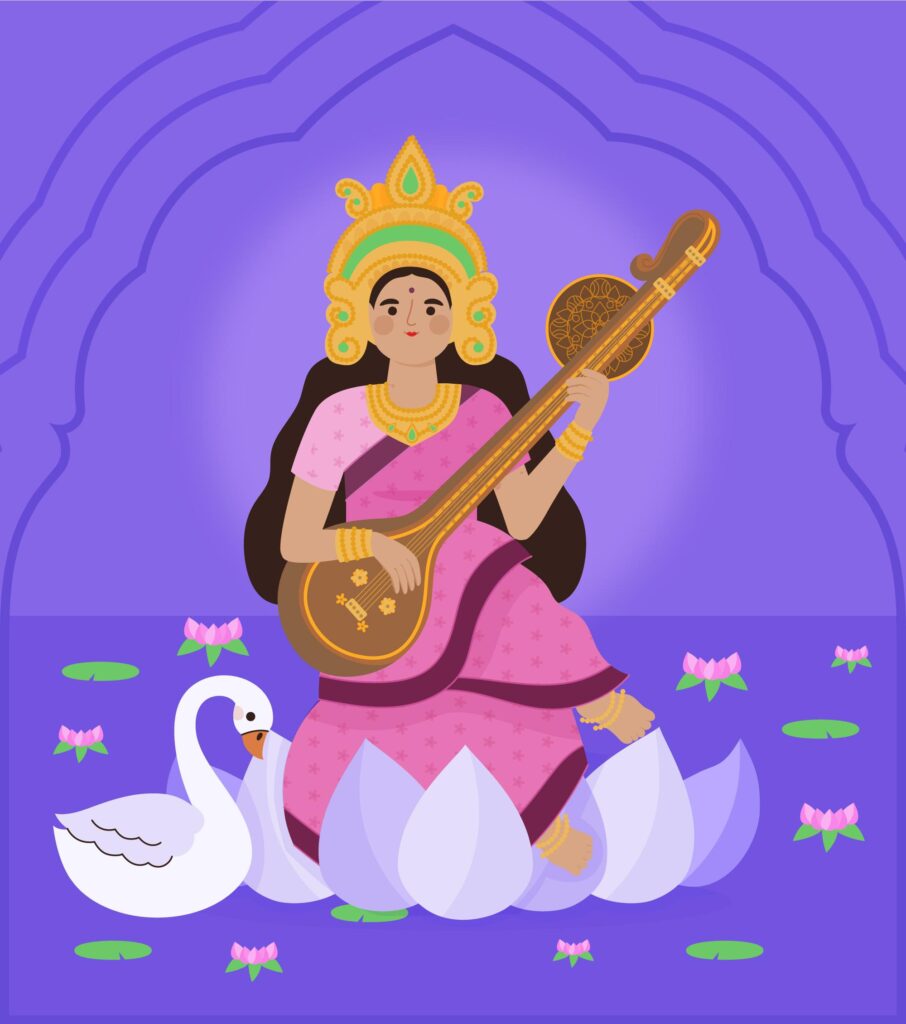Vasant Panchami or Saraswati Puja
Basant Panchami also known as Saraswati Puja, marks the arrival of spring. It marks the start of preparation for Holi which is celebrated forty days later. The festival is celebrated forty days before the arrival of spring because any season takes forty days to be in full bloom. Spring is also known as the “King of all seasons”.
Saraswati Puja

The festival honors Goddess Saraswati, the goddess of knowledge, language, music, and all arts. She symbolizes creativity. The festival celebrates the agricultural fields ripening with yellow flowers and mustard crops. Yellow is Maa Saraswati’s favorite color according to Hindu mythology. People dress in yellow and eat yellow sweets or food.
Some families sit with their young ones encouraging them to write their first words, create music, study, or do some art. Temples filled with food so that Maa Saraswati can join the feast. Devotees worship Maa Saraswati adorned in yellow at various temples and educational institutions. Special prayers and musical or poetic gatherings are all part of the celebration.
Kama
Pradyumna the son of Sri Krishna and Devi Rukmini, is the reincarnation of Kama who is the Hindu God of Love. Thus, Basant Panchami is also known as Madana Panchami. Kama awakens the passion of the earth and its people.
Lord Shiva and Parvati
It is believed that on this day, the Rishis approached Kama to awaken Lord Shiva from his yogic meditation. They helped Parvati to get Lord Shiva as her husband and get him back from his meditation to worldly desires with help from Kama. Kama threw arrows made from flowers and bees at Lord Shiva from his bow in order to arouse him from meditation to pay attention to Parvarti. After his awakening, Lord Shiva burnt Kama to ashes. Vasant Panchami marks this event.

Celebrations in Gujarat
People prepare bouquets and garlands of flowers set with mango leaves as gifts. People wear colorful clothes and sing songs related to Sri Krishna and Radha.
Deo Temple
On this day, the Deo-Sun shrine, the shrine of the Sun god in Aurangabad district, Bihar was established. King Aila of Allahabad found this shrine. The statues are washed, old clothes are replaced, and devotees sing, dance, and play music.

Celebrations across and around the country
- In eastern India like West Bengal, Assam, Tripura, and Bihar along with Nepal, people worship Goddess Saraswati at schools and temples.
- Bangladesh observes a holiday on this day.
- Various educational institutions in Odisha host Yajana ceremonies. Four to five-year-old children start learning on this day in a unique ceremony called “Khadi-Chua” or “Vidya-Arambha”.
- Southern states like Andhra Pradesh call it Sri Panchami.
- In Maharashtra, Madhya Pradesh, Chattisgarh, and Uttar Pradesh people worship Lord Shiva and Parvati after bathing in the morning.
- In Rajasthan, it is customary for people to wear jasmine garlands.
- In Maharastra, newlyweds visit temples and offer prayers on their first Vasant Panchami.
- In Punjab, it is celebrated as the Basant festival of kites. Children buy kites and dor.
- In Bali among Indonesian Hindus, Hari Raya Saraswati (the local name of the festival) is celebrated with prayers in family compounds, educational institutions, and, public venues from morning to noon.
Sikhism
Sikhs mark this day to celebrate the onset of spring. They wear yellow clothes and enjoy kite flying. Sikhs remember the martyrdom of the child Haqiqat Rai. Muslim ruler Khan Zakariya Khan arrested him after falsely accusing him of insulting Islam. The child was given a choice to either convert to Islam or die. He refused the conversion and was executed on Basant Panchami in 1741 in Lahore, Pakistan.
Sufism
According to Lochan Singh Buxi, some Indian Muslim Sufis celebrate Basant Panchami since the 12th century to mark the grave of the Muslim Sufi saint dargah of Nizamuddin Aulia in Delhi. The poet Amir Khusrau saw Hindu women dressed in yellow, carrying yellow flowers to the temple on Basant. He adopted this culture to give some happiness to Nizamuddin Aulia because his nephew died a few days ago and he was not recovering from grief.
